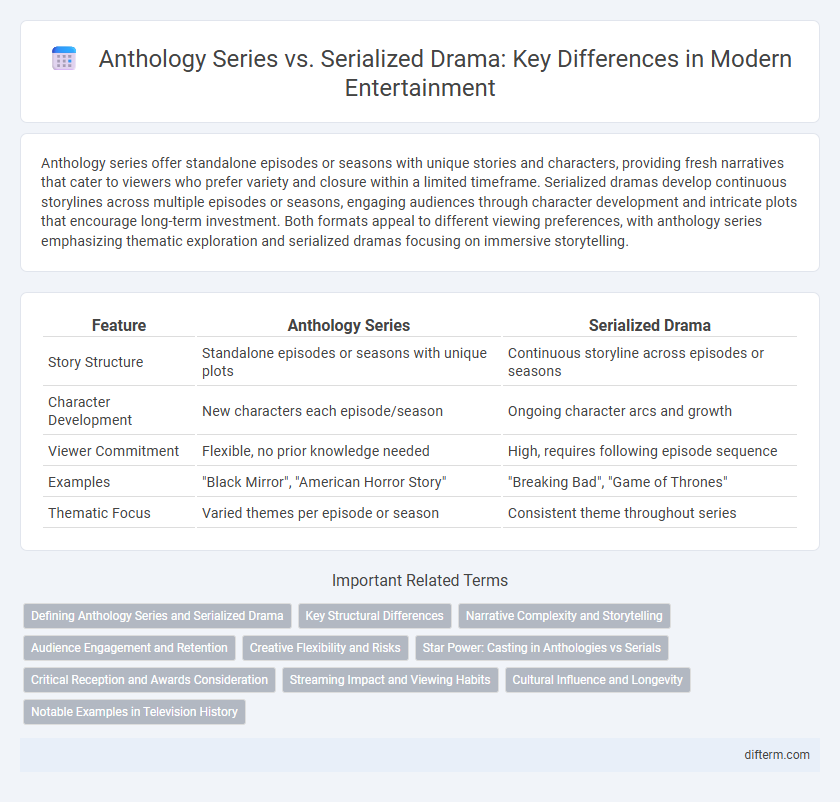Anthology series offer standalone episodes or seasons with unique stories and characters, providing fresh narratives that cater to viewers who prefer variety and closure within a limited timeframe. Serialized dramas develop continuous storylines across multiple episodes or seasons, engaging audiences through character development and intricate plots that encourage long-term investment. Both formats appeal to different viewing preferences, with anthology series emphasizing thematic exploration and serialized dramas focusing on immersive storytelling.
Table of Comparison
| Feature | Anthology Series | Serialized Drama |
|---|---|---|
| Story Structure | Standalone episodes or seasons with unique plots | Continuous storyline across episodes or seasons |
| Character Development | New characters each episode/season | Ongoing character arcs and growth |
| Viewer Commitment | Flexible, no prior knowledge needed | High, requires following episode sequence |
| Examples | "Black Mirror", "American Horror Story" | "Breaking Bad", "Game of Thrones" |
| Thematic Focus | Varied themes per episode or season | Consistent theme throughout series |
Defining Anthology Series and Serialized Drama
Anthology series present self-contained episodes or seasons, each featuring distinct characters, settings, and storylines, enabling varied thematic exploration without narrative continuation. Serialized dramas deliver continuous storytelling across episodes, with ongoing character development and plot progression that require sequential viewing for full comprehension. This structural difference shapes viewer engagement, where anthology series offer standalone experiences and serialized dramas build emotional investment through long-term narrative arcs.
Key Structural Differences
Anthology series feature self-contained episodes or seasons with distinct storylines, characters, and settings, providing viewers with complete narratives in each installment. Serialized dramas present continuous plots across episodes, developing characters and story arcs over time, encouraging sustained audience engagement. The structural distinction lies in the standalone format of anthologies versus the interconnected, evolving storylines in serialized dramas.
Narrative Complexity and Storytelling
Anthology series offer self-contained narratives with distinct themes and characters each season or episode, allowing diversified storytelling and thematic exploration. Serialized dramas develop complex, interconnected storylines over multiple episodes or seasons, fostering deep character arcs and sustained plot development. Narrative complexity in serialized dramas often results in intricate, layered plots that require audience investment, while anthology series emphasize varied storytelling styles and standalone narrative closure.
Audience Engagement and Retention
Anthology series captivate audiences by offering fresh stories and characters each episode or season, reducing viewer fatigue and attracting new viewers with varied themes. Serialized dramas build deep emotional investment and sustained engagement through continuous plotlines and complex character development, encouraging binge-watching and long-term loyalty. Understanding audience preferences for novelty versus narrative depth is crucial for maximizing retention and engagement in entertainment programming.
Creative Flexibility and Risks
Anthology series offer greater creative flexibility by presenting distinct stories and characters each season, allowing writers and directors to explore diverse themes without narrative constraints. Serialized dramas, while providing deep character development and complex plotlines, carry higher risks of viewer fatigue and storyline stagnation over extended episodes. The choice between formats significantly impacts storytelling approach, audience engagement, and production challenges within the entertainment industry.
Star Power: Casting in Anthologies vs Serials
Anthology series often attract star power by casting high-profile actors for limited episodes, creating buzz with fresh talent in each season or installment. Serialized dramas rely on consistent, well-known leads to build audience loyalty and character development over multiple episodes or seasons. The strategic casting in anthologies leverages celebrity appeal intermittently, while serialized dramas benefit from ongoing star-driven narratives enhancing viewer engagement.
Critical Reception and Awards Consideration
Anthology series often receive critical acclaim for their unique storytelling format, allowing different narratives and casts each season, which appeals to award bodies seeking innovation and artistic versatility. Serialized dramas are frequently praised for deep character development and complex, ongoing story arcs, making them strong contenders in acting and writing categories at prestigious awards such as the Emmys and Golden Globes. Critical reception tends to favor anthology series for artistic risk-taking, while serialized dramas garner accolades for sustained narrative excellence and emotional depth.
Streaming Impact and Viewing Habits
Streaming platforms have transformed viewing habits by popularizing anthology series, which cater to binge-watching with self-contained, varied storylines per season, appealing to viewers seeking diverse narratives without long-term commitment. Serialized dramas maintain strong engagement through continuous, evolving plots that encourage weekly viewing and social media discussions, leveraging cliffhangers to sustain subscriber retention. The flexibility of streaming services supports both formats, but anthology series benefit from the platform's ability to attract sporadic viewers, while serialized dramas thrive on sustained audience investment.
Cultural Influence and Longevity
Anthology series offer unique narratives each season or episode, allowing diverse cultural themes to be explored deeply, which fosters fresh audience engagement and critical acclaim. Serialized dramas build long-term character development and complex story arcs that resonate with viewers over time, enhancing cultural impact through sustained viewer investment and discussion. The longevity of serialized dramas stems from their ability to evolve with societal changes, while anthology series maintain cultural relevance by reflecting distinct sociocultural moments in each installment.
Notable Examples in Television History
Anthology series such as "The Twilight Zone" and "Black Mirror" showcase standalone stories with unique characters and settings in each episode, allowing diverse themes and creative flexibility. Serialized dramas like "Breaking Bad" and "Game of Thrones" develop complex narratives and character arcs across multiple episodes or seasons, enhancing viewer engagement through continuous plot development. Both formats have significantly shaped television history by offering distinct storytelling approaches that cater to varying audience preferences.
anthology series vs serialized drama Infographic

 difterm.com
difterm.com